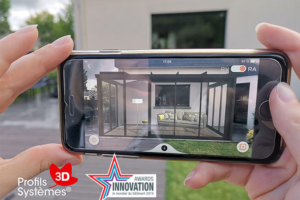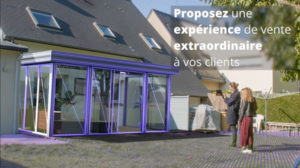La démocratisation des applications en réalité augmentée
Le domaine de la réalité augmentée explose. Ce sont des dizaines de nouvelles applications
intégrant cette technologie qui sont créées par mois. Adoptée par de nombreuses
industries comme le luxe ou même le divertissement, toutes les marques veulent leur application en Réalité Augmentée.
Des applications pour tous
Il existe aujourd’hui un grand nombre d’applications pour téléphones et tablettes qui s’appuient sur la réalité augmentée dans le but de proposer une nouvelle expérience.
Vous connaissez sûrement l’appli Snapchat. Saviez-vous que ce réseau social a été le premier à croire aux technologies d’augmentation ? Leurs filtres en réalité augmentée sont, à ce jour, leur plus grosse valeur ajoutée. Outre le fait d’avoir introduit la RA auprès du grand public, cette start-up a aussi démontré le potentiel économique de cette technologie. Pas étonnant que tous les réseaux sociaux aient suivi cette tendance dans leurs applications.
Aujourd’hui, entreprises comme particuliers, tout le monde peut créer ses propres filtres que ce soit pour un usage privé (mariages, anniversaires, …) ou professionnel (événements, campagnes marketing, etc.). Par exemple, une entreprise peut inviter les utilisateurs à se prendre en photo avec un filtre personnalisé pour promouvoir un nouveau produit ou pour participer à un concours.
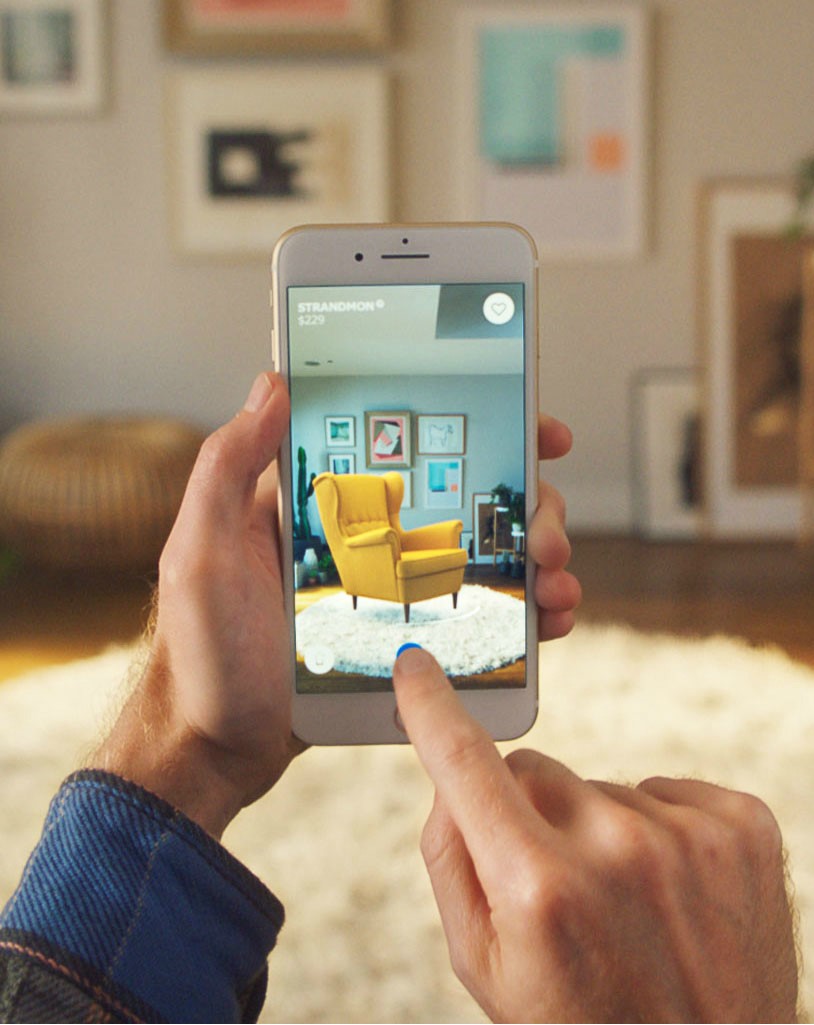
Pokémon Go, ça vous dit quelque chose ? Cette application est l’emblème du phénomène Réalité Augmentée. Ce jeu, sorti en 2016, permet de chasser des Pokémons à travers le monde. Pokémon GO fut une réussite commerciale incontestable.
Des applications grand public, que vous connaissez sans doute, utilisent elles aussi la réalité augmentée pour faciliter et encourager l’achat. IKEA Place, par exemple, offre une visualisation de n’importe quel meuble du catalogue IKEA directement chez soi à taille réelle. L’appli YouCam MakeUp permet d’essayer les produits de beauté L’Oréal, virtuellement, sur son visage.
Les professionnels également équipés d’applications en réalité augmentée
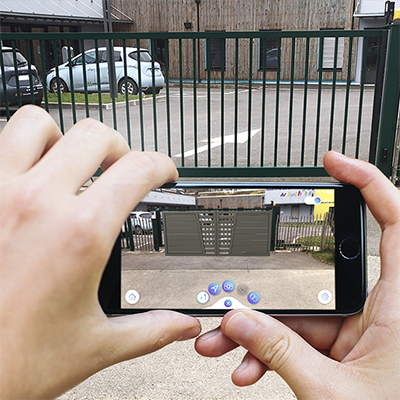
Si la réalité augmentée se démocratise auprès du grand public, elle devient également un redoutable outil d’aide à la vente pour les professionnels. En effet, elle permet aux clients de visualiser les produits et de se projeter facilement dans un nouvel environnement.
C’est notamment le cas des catalogues augmentés qui se développent chez de nombreux fabricants. Fonctionnant sur le même principe qu’IKEA Place, ces outils permettent aux commerciaux de proposer à leurs clients une visualisation de leurs produits en taille réelle (soit depuis chez eux ou en magasin) et de le commander depuis l’application. Imaginez alors le potentiel : montrer des piscines, des vérandas, ou encore des éléments de décoration intérieures de manière réaliste grâce à une simple application pour smartphones et tablettes. Cette expérience d’achat, tous les consommateurs la veulent aujourd’hui.
Urbasee l’a fait ! Il suffit de charger les modèles 3D des produits souhaités dans votre espace de gestion. Du mobilier aux maisons, projetez-les en réalité augmentée depuis votre smartphone ou tablette, devant le client afin de lui montrer le résultat final avant réalisation.
Des outils pour rendre le développement en réalité augmentée accessible
ARKit d’Apple et ARCore de Google permettent aux développeurs de créer des applications en réalité augmentée de manière amplement simplifiée. Si vous souhaitez en connaitre les ressorts, on ne peut que vous conseiller de lire notre article sur ces deux kits de développement logiciel !
Les nouvelles tendances en RA
La réalité augmentée ne cesse de gagner en popularité ces dernières années. De nombreux effets significatifs sont observés sur différentes industries.
Ces 6 premiers mois de 2021 ont été florissant pour l’industrie de la réalité augmentée. Entre le contrat reliant Microsoft et l’armée américaine pour la vente de 120 000 casques de réalité augmentée et la sortie des dernières lunettes Spectacles de Snapchat, cette année est pour l’instant rythmée par l’émergence d’un monde de plus en plus « futuriste ».
À ce jour, la Réalité Augmentée présente des avantages indéniables pour la formation et l’enseignement. Elle permet notamment d’améliorer la productivité des employés grâce à une pratique des tâches en temps réel et sans risques.
Sur le plan social, il s’avère que la Réalité Augmentée devient de plus en plus adoptée dans le quotidien des entreprises. Pour dynamiser les réunions ou simplement dans le but de rendre le cadre de travail plus collaboratif, de nombreux chefs d’entreprise optent pour les nouvelles technologies.
Les constructeurs automobiles surfent, eux aussi, sur la vague de la RA. Grâce à l’usage de caméras et d’un écran installé sur le tableau de bord du véhicule, les dangers sur la route peuvent aujourd’hui être signalés.
Qu'est-ce que le futur réserve à la réalité augmentée ?
Ce qui nous intéresse particulièrement c’est de savoir à quel degré la Réalité Augmentée sera présente dans notre quotidien d’ici quelques années. Et certaines réponses sont déjà envisagées.
Fin 2020, Mark Zuckerberg confiait que selon lui, « la réalité augmentée permet de se sentir plus que jamais en contact avec le monde qui nous entoure. Et ce, même à distance. Au fur et à mesure des années et des évolutions, nous ne serons plus limités à un écran, nous pourrons ressentir, entendre et voir des personnes ou des objets autour de nous, en temps réel. »
Le patron de Facebook évoque même la possibilité de ne plus avoir besoin d’appareils physiques (smartphones, tablettes, etc.).
Alors, tendons-nous vers la fin des écrans pour laisser place aux hologrammes qui nous permettront de remplacer les livres, les médias, les consoles de jeux ou encore les télévisions ?
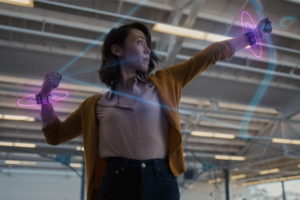 Pour ce qui est des nouveaux projets de recherche, le Facebook Bracelet Bellowband s’ajoute aux traditionnels casques et lunettes pour rendre les interactions plus intuitives. Le Bellowband, intégrant l’électromyographie (EMG), sera capable de mesurer les signaux nerveux qui traversent le bras. Ce bracelet permettra de contrôler les objets virtuels au millimètre près grâce à une technologie de capteurs.
Pour ce qui est des nouveaux projets de recherche, le Facebook Bracelet Bellowband s’ajoute aux traditionnels casques et lunettes pour rendre les interactions plus intuitives. Le Bellowband, intégrant l’électromyographie (EMG), sera capable de mesurer les signaux nerveux qui traversent le bras. Ce bracelet permettra de contrôler les objets virtuels au millimètre près grâce à une technologie de capteurs.
Zuckerberg, annonce également l’idée du projet Aria en collaboration avec Ray-Ban. « Des lunettes de réalité augmentée qui permettraient de nous aider dans nos tâches quotidiennes. Cette paire de lunettes ajouterait une couche 3D d’informations utiles, contextuellement pertinentes et significatives au-dessus du monde physique. »
Maintenant qu’elle s’est installée, et qu’elle a prouvé son potentiel utilitaire et économique, la réalité augmentée a un futur radieux devant elle et l’on peut rapidement s’attendre à voir ses usages se multiplier. Elle pourrait bien transformer à la fois notre vie quotidienne et la façon dont nous interagissons avec notre environnement, mais aussi de nombreux corps de métiers comme le bâtiment, l’architecture, la médecine ou l’industrie !


